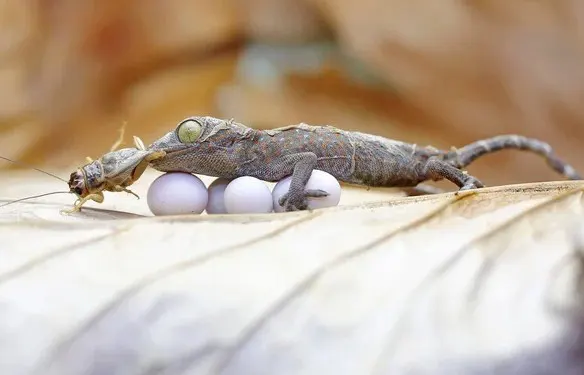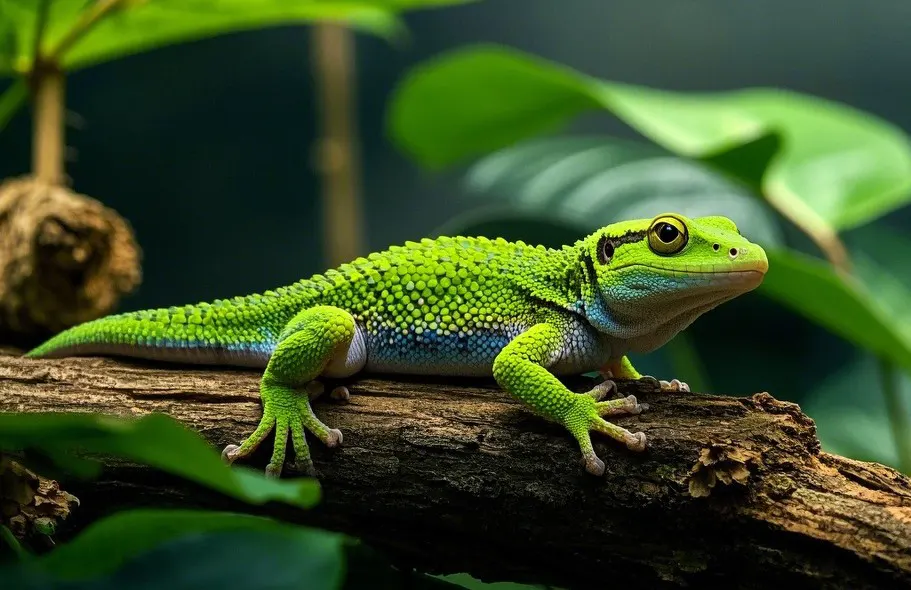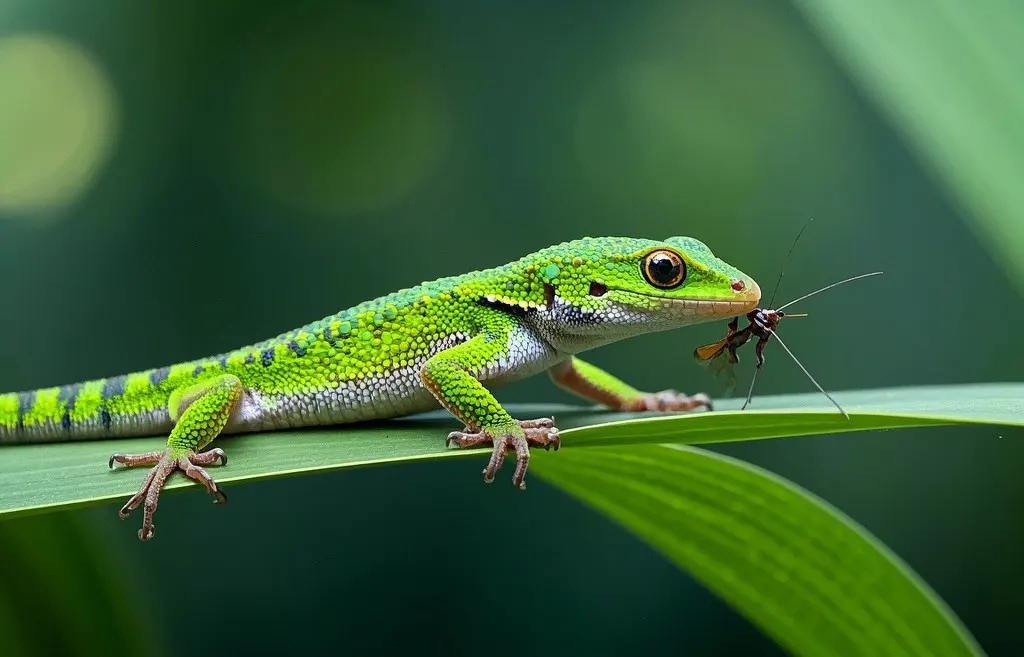Comprehensive Gecko Care Guide
Gecko Pet Care Essentials
Welcome to the essential guide for gecko care! Providing the right environment, diet, and attention is crucial for your gecko’s health, longevity, and happiness. Remember that “gecko” encompasses many species with diverse needs (e.g., Leopard, Crested, Day, Gargoyle, African Fat-Tailed). Always research the specific requirements for your particular species. This guide covers the fundamental aspects applicable to many common pet geckos.

Habitat & Enclosure
Creating a safe, stimulating, and properly regulated environment is paramount.
- Enclosure Type: Glass terrariums are common. Front-opening options make access easier. Plastic tubs can work for quarantine or simple setups but may need added ventilation. Ensure any enclosure has a secure lid to prevent escapes.
- Tank Size: Varies greatly by species and age. A 20-gallon long tank is often a good *minimum* for an adult Leopard Gecko. Arboreal species (like Crested Geckos) need *vertical* space (e.g., 18x18x24 inches). More space is generally better, allowing for better temperature gradients and enrichment.
- Substrate: Choose function and safety. Paper towels are excellent for quarantine and babies (easy to monitor health). Reptile carpet, non-adhesive shelf liner, and slate/ceramic tiles are safe, reusable options. Bioactive setups (naturalistic with live plants and cleanup crews) are popular but require significant research and setup. **Strictly avoid loose substrates like calcium sand, walnut shells, or wood chips for most species (especially Leopard Geckos) due to high impaction risk.** Coconut fiber or organic topsoil mixes *may* be suitable for some *tropical* species when kept appropriately moist, but still carry some risk if ingested excessively.
- Temperature Gradient: Reptiles are ectothermic and need external heat to regulate body temperature. Provide a warm side and a cool side.
- Warm Side: Use an Under Tank Heater (UTH) controlled by a **thermostat** (essential!) placed *under* one side of the tank for belly heat (ideal for Leopard Geckos). Target temps vary (e.g., 88-92°F / 31-33°C floor temp for Leos). Overhead heat (Ceramic Heat Emitter – CHE, Deep Heat Projector – DHP) controlled by a thermostat can also provide ambient heat, especially in larger tanks or for species needing higher air temps.
- Cool Side: Should remain at ambient room temperature, typically around 70-77°F (21-25°C), allowing the gecko to thermoregulate.
- Monitoring: Use digital thermometers with probes placed *at substrate level* on both warm and cool sides. Infrared temp guns are great for spot-checking surface temperatures. **Never use heat rocks – they overheat dangerously and cause severe burns.**
- Humidity: Crucial for shedding and respiratory health. Requirements vary drastically:
- Arid Species (e.g., Leopard Geckos): Need lower ambient humidity (30-40%) but require a dedicated “humid hide” – a hide box containing moist substrate like sphagnum moss, coco fiber, or paper towels, especially vital during shedding.
- Tropical Species (e.g., Crested Geckos): Need higher ambient humidity (60-80%). This is usually maintained by regular misting (manual or automatic system), appropriate substrate choice, and sometimes limiting excessive ventilation (while still ensuring adequate air exchange).
- Monitoring: Use a reliable digital hygrometer to measure humidity levels.
- Hides & Decor: Essential for security and enrichment. Provide *at least* three hides: one on the warm side, one on the cool side, and one moist hide (usually on the warm side or in the middle). Offer climbing opportunities (branches, cork bark, vines) for all species, but especially arboreal ones. Fake or safe live plants provide cover and enhance the environment. Rocks (ensure stability) can add basking surfaces or texture.
Lighting & Day/Night Cycle
Proper lighting influences activity cycles, behavior, and potentially health.
- Day/Night Cycle: Provide a consistent cycle of light and darkness (typically 12 hours on, 12 hours off, adjusting seasonally if desired). Use a timer for reliability. Avoid bright lights at night; if nighttime viewing is needed, use a dim, non-disruptive red or “moonlight” blue bulb sparingly.
- UVB Lighting: This is a complex topic with species-specific needs.
- Requirement: Many diurnal (day-active) geckos (like Day Geckos) *require* UVB lighting to synthesize Vitamin D3 and properly metabolize calcium. Crepuscular/nocturnal species (like Leopard Geckos, Crested Geckos, AFTs) have lower requirements. While they *can* often get D3 from diet supplements, providing low levels of appropriate UVB (e.g., ShadeDweller type bulbs) is increasingly recommended for potential health benefits, allowing for more natural D3 synthesis and potentially better overall well-being.
- Type & Placement: Linear fluorescent tubes (T5 HO or T8) are generally preferred over compact bulbs for better coverage. The percentage/strength needed (e.g., 5%, 7%, 10%) and placement distance depend heavily on the species, bulb type, and whether it’s mounted above or below a screen lid (which filters UVB). Follow manufacturer guidelines and species-specific recommendations.
- Replacement: UVB output degrades over time *before* the bulb burns out. Replace UVB bulbs every 6-12 months based on manufacturer recommendations.
- Visible Light: If the room is dim, a simple LED light can be used during the day to simulate daylight and support plant growth (if using live plants), separate from the heat or UVB source.
Diet & Nutrition
A varied, well-supplemented diet is key to preventing nutritional deficiencies.

- Food Type: Most common pet geckos are insectivores. Some (Crested, Gargoyle, Day Geckos) are also frugivores/nectarivores.
- Insectivores: Offer a *variety* of appropriately sized live insects. Staples include crickets, dubia roaches, black soldier fly larvae (BSFL/Calci-worms), and silkworms. Mealworms and superworms can be offered moderately (higher in fat/chitin). Waxworms and hornworms are high-fat/high-moisture treats.
- Frugivores/Nectarivores: Primarily feed high-quality commercial “Complete Gecko Diets” (CGD) formulated for the species (e.g., Pangea, Repashy). Mix powder with water as directed. Supplement with insects 1-2 times a week. Avoid feeding baby food (poor nutrition).
- Gut-Loading: Crucial for insectivores. Feed nutritious food (commercial gut-load diets, oats, leafy greens, vegetables like carrots or sweet potatoes – research safe options) to feeder insects for 24-48 hours *before* offering them to your gecko. What the insect eats, your gecko eats.
- Supplementation: Essential to prevent Metabolic Bone Disease (MBD).
- Calcium w/ D3: Dust insects lightly at most feedings for geckos *not* receiving adequate UVB lighting.
- Calcium (No D3): Dust insects lightly at most feedings for geckos that *are* receiving adequate UVB lighting. A small dish of plain calcium can sometimes be offered in the enclosure, though monitor intake.
- Multivitamin: Dust insects with a reptile multivitamin containing Vitamin A (preformed retinol, not just beta-carotene for many species) once every 1-2 weeks (follow product instructions).
- Balance: Do not over-supplement, as this can also cause health issues. Lightly dusting is key.
- Feeding Schedule & Amount: Young, growing geckos typically eat daily. Adults may eat every other day or a few times a week. Offer as many appropriately sized insects as they will readily consume in about 10-15 minutes. Remove uneaten insects (especially crickets, which can bite).
- Water: Provide a shallow, stable dish of fresh, clean water at all times. Change it daily and clean the bowl regularly. Use dechlorinated water if your tap water is heavily chlorinated.
Handling & Shedding
Gentle interaction and monitoring shedding are important aspects of care.

- Acclimation: Allow new geckos at least 1-2 weeks to settle into their new home before attempting handling. Minimize stress during this period.
- Handling Technique: Approach slowly and calmly. Gently scoop the gecko from underneath; never grab from above (predator response) or by the tail. Support their full body. Start with short sessions (5 minutes) and gradually increase duration as the gecko becomes comfortable. Handle over a soft surface in case of jumps/falls.
- Frequency: Handling tolerance varies by individual and species. Some geckos tolerate regular handling well; others remain skittish. Observe your gecko’s body language for stress signs (fast breathing, trying to flee, defensive posture, vocalizing) and end sessions if needed.
- Tail Autotomy (Tail Dropping): Many geckos can detach their tails as a defense mechanism if they feel threatened or restrained by the tail. It will regrow but often looks different (stubbier, different color/pattern). If this happens, keep the enclosure extra clean to prevent infection of the stump. Never intentionally grab the tail.
- Shedding (Ecdysis): Geckos shed their skin periodically as they grow. Signs include dull/whitish skin and cloudy eyes. Most geckos eat their shed skin (it’s nutritious!). Proper humidity (especially in the humid hide) is vital for a complete shed.
- Shedding Problems (Dysecdysis): Stuck shed, especially on toes, tail tips, or around eyes, is common if humidity is too low. This can constrict blood flow and lead to tissue loss. If you notice stuck shed after a day or two, you can:
- Increase humidity/ensure the humid hide is moist.
- Give the gecko a “sauna”: place it in a small container with ventilation holes and a lukewarm, damp paper towel (not standing water) for 10-20 minutes.
- After a soak/sauna, gently try to roll the stuck shed off with a damp cotton swab (Q-tip). Never pull hard.
- Persistent stuck shed may require veterinary attention.
Enclosure Cleaning & Maintenance
Maintaining a clean habitat prevents disease and odors.
- Daily: Spot clean feces and urates. Remove uneaten food. Change water and wipe the water dish.
- Weekly: Thoroughly clean water and food dishes. Wipe down surfaces if needed. Check temperatures and humidity.
- Monthly (or as needed): Perform a more thorough clean. If using simple substrate (paper towel, tile), replace/wipe down. If using loose substrate, sift or partially replace as needed. Wipe down enclosure walls and decor.
- Deep Cleaning (Every 1-3 months): Temporarily move the gecko to a secure holding container. Remove all substrate and decor. Scrub the enclosure and all furnishings with a reptile-safe disinfectant (like diluted Chlorhexidine or F10 solution) or a vinegar/water solution. **Rinse everything thoroughly** with plain water and allow it to dry completely before returning substrate, decor, and the gecko. Avoid harsh household cleaners (bleach, pine-based cleaners) as their fumes can be toxic.